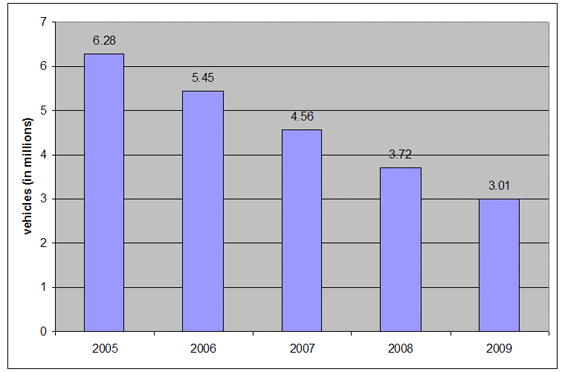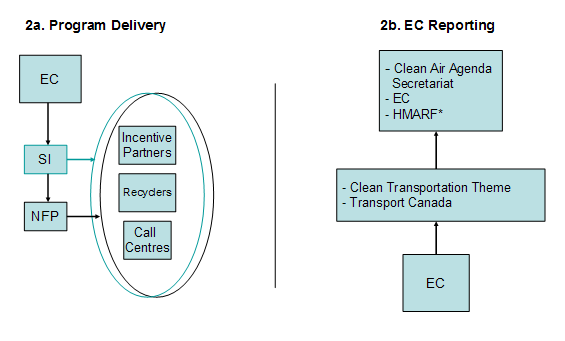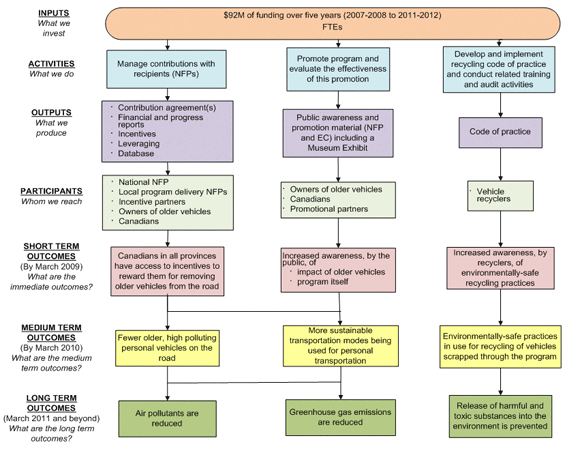
Source: Statistics Canada, Canadian Vehicle Survey; Annual, 53-223-X
Final Report
July 12, 2011
Previous page | Table of Contents | Next page
This section provides the background and main parameters of the NVSP. It is based on program documentation and financial data (see Annex 1 for bibliography).
The main goal of the NVSP (known as Retire Your Ride [RYR] / Adieu bazou) was to accelerate the removal of older, higher-polluting vehicles from Canada’s roads. Participants retiring their vehicle through the program received a reward worth at least $300. The program’s target was 50 000 retired vehicles per year.
Secondary goals of the NVSP were to reduce greenhouse gas (GHG) emissions by encouraging the uptake of sustainable transportation choices, and to prevent the release of toxic substances into the environment through responsible vehicle recycling.
The NVSP defined an “older” vehicle as being model-year 1995 or older. This cut-off date was selected because new vehicle emission standards were tightened in 1996 (as they were again in 2004). Because of these changes, older vehicles pollute more than newer ones. For example, vehicles from model-year 1995 and previous years produce 19 times more smog-forming pollutants than vehicles from model-year 2004 and subsequent years.
When the NVSP was announced in 2007, 4.6 million of the estimated 18 million personal vehicles in use in Canada were model-year 1995 or older (Figure 1). In 2009 (the most recent year for which these data are available), 3 million older vehicles were still being driven and still polluting the air.
Figure 1: Number of Model-year 1995 and Earlier Vehicles on the Road, by Year (in millions)

Source: Statistics Canada, Canadian Vehicle Survey; Annual, 53-223-X
Smog is the noxious mixture of ground-level ozone and particulate matter (PM). Ground-level ozone, a respiratory irritant, is formed through a complex series of reactions involving volatile organic compounds (VOCs) and nitrogen oxide (NOx), two substances found in the exhaust gases of personal vehicles. Although significant health impacts arise from PM as well, the NVSP focused on NOx and VOCs reductions, because personal vehicles are not large emitters of PM.
In many well-designed short- and long-term exposure studies, higher levels of smog were associated with increased human mortality and morbidity. Smog also had negative environmental impacts, as vegetation health and productivity is harmed by pollutants like ground-level ozone (Environment Canada March 2011a). Furthermore, smog can harm wildlife, their habitat, and the availability and quality of their food supply (Environment Canada, 2011b).
Personal vehicles also emit GHGs, which have been linked to human-influenced climate change. GHGs are emitted through the burning of fossil fuels, alongside the smog-forming pollutants discussed above. However, unlike smog-forming pollutants, GHG emissions cannot be reduced significantly through emission-reduction technology; GHGs are reduced by burning less fuel. This can be achieved by reducing personal vehicle usage, driving vehicles with improved fuel efficiency, or switching to more sustainable modes of transportation like public transit and cycling.
Vehicles cause further damage to the environment if they are not recycled with high environmental standards. Toxic or harmful substances like oil, antifreeze and mercury need to be removed and stored properly in order to prevent their release into the environment.
The federal government has been involved in accelerated vehicle retirement initiatives for over a decade. Between 2001 and 2008, EC provided approximately $500,000 per year for the delivery of seven local vehicle scrappage programs in six provinces. The NVSP was the first scrappage program at the national level and, when fully implemented, had an annual budget of $26–$30 million.
Funding of up to $92 million was provided to the NVSP over five years (2007-2008 to 2011-2012) from funds set aside in Budget 2005 and Budget 2007. The NVSP ended on March 31, 2011, and, as intended, was not renewed.
Table 1: NVSP 5-year Budget Allocation (in $ millions)
Salary and benefits
$1.70
Operations and maintenance (O&M)
$8.63
Grants and contributions (G&Cs)
$79.98
Corporate support
$1.70
Total
$92.00
In 2007, EC set up a separate contribution authority for the NVSP. In 2008, Summerhill Impact (SI) (named Clean Air Foundation at that time), a not-for-profit organization (NFP) specializing in environmental public engagement campaigns, signed a contribution agreement with EC to receive $62.2 million in funding over four years for program delivery and incentives.
Funding to SI was used to support its role as national program coordinator, which included establishing partnerships, distributing incentives to Canadians, and promoting the program at the local level. SI delivered the program through a network of regional NFPs that also delivered public education and outreach programming (see Annex 2). As well, these NFPs provided a network of call centres and automotive recyclers, and carried out the daily interaction with participants in RYR.
The NVSP was one of a range of complementary clean transportation initiatives undertaken in partnership with other departments as part of the Clean Air Agenda (CAA). The CAA’s spending for the first three years of its four-year mandate was $1.34 billion; the planned spending was $1.55 billion. Total planned spending for all federal departments in 2010-2011 was reported as $951.3 million.
To participate, vehicle owners submitted an online application or called the program’s toll-free number. Once the application was approved, the collection of the vehicle was arranged by the NFP in partnership with local vehicle recyclers. In most cases the owner signed the vehicle over to the recycler, who then confirmed that the vehicle had been collected. In other cases, the owner could drive the vehicle to a pre-approved drop-off location. The NFP then provided the participant with an incentive of their choice.
Eligible vehicles were personal automobiles and light-duty trucks of model-year 1995 and earlier. They were required to be in running condition, and to have been registered and insured in the owner’s name in Canada for the previous consecutive six months (12 months in B.C.). In accordance with program guidelines, vehicles were required to be:
A cash incentive of $300 was available everywhere that the program was offered. Non-cash incentives, which varied among the provinces and communities, included rebates on newer vehicles, transit passes, discounts on bicycles and e-bikes, and memberships in car-sharing programs. The non-cash incentives were all worth more than the $300 cash incentive and were offered to encourage participants to move toward more environmentally friendly methods of transportation. Many of the non-cash incentives were leveraged by SI with the $300 allotted to each vehicle accepted into the program.
SI also negotiated partnerships with automobile manufacturers who offered rebates on the purchase of a new vehicle. The manufacturers absorbed the full price of these offers, because the terms and conditions of RYR prohibited the use of federal incentive dollars for vehicle rebates. For RYR participants, this meant that auto manufacturer rebates were a “top-up” to the RYR incentive of their choice.
EC worked with the Automotive Recyclers of Canada (ARC) to develop a national code of practice for vehicle recycling, in order to ensure consistent and high environmental practices for vehicles retired under the program. Participating recyclers were required to follow this code, and on-site audits were conducted (under contract) to verify their compliance.
EC conducted a financial audit of SI to verify that it was complying with the terms of the contribution agreement and that its financial system was effective. Preliminary findings of this audit were used to adjust financial monitoring by SI. Final audit results were not available for the current evaluation.
EC also provided funding to the Canadian Urban Transit Association for the development and delivery of a public awareness campaign for the program. The campaign placed special emphasis on transit incentives.
In addition, EC’s Biosphère museum developed exhibits and short movies on vehicle recycling and sustainable transportation.
The NVSP, part of the CAA, complemented the Agenda’s GHG regulations (which take effect starting with model-year 2011 vehicles), Transport Canada’s ecoAUTO rebates that encouraged the purchase of fuel-efficient vehicles, Transport Canada’s ecoMOBILITY program that increased the use of public transit and alternative transportation, and Natural Resources Canada’s ecoENERGY for Personal Vehicles program that encouraged better purchasing, driving and maintenance practices.
In EC’s Program Activity Architecture, the NVSP was intended to contribute to the strategic outcome “Threats to Canadians and their environment from pollution are minimized,” under the Architecture’s sub-sub-activity 3.2.2 “Climate Change and Clean Air Partnerships.”
Within EC, the NVSP was managed and delivered by the Outreach Division of the Environmental Stewardship Branch. The NVSP team was responsible for managing the contribution agreement with SI, including the monitoring of its activities and results.
Figure 2a shows the chain of contribution agreements and contracts put into place for program delivery. EC signed a contribution agreement with SI, which, in turn, signed separate agreements with provincial NFPs. Either through a contract with a third party or through their existing agreements, SI and the NFPs delivered the incentives, the auto recycling services and the call centre services. Reports from these relationships fed EC’s reporting obligations. Figure 2b shows EC’s internal and intergovernmental reporting.
Figures 2a and 2b: Schematic of Program Delivery and EC Reporting

*Horizontal Management Accountability and Reporting Framework
Text Description for Figures 2a and 2b
Information on the program’s financial resources over the five-year time frame from 2007-2008 to 2011-2012 is presented in Table 2.
| 2007-08 | 2008-09 | 2009-10 | 2010-11 | 2011-12 | All years | |
|---|---|---|---|---|---|---|
| Source: EC financial information | ||||||
| Treasury Board funding | 1.50 | 13.15 | 34.76 | 41.39 | 1.20 | 92.00 |
| Direct program support | ||||||
| Actual | Actual | Actual | Actual | Planned | ||
| Salaries | 0.24 | 0.23 | 0.26 | 0.24 | 0.00 | 0.97 |
| O&M | 0.22 | 0.75 | 0.76 | 0.60 | 0.00 | 2.33 |
| G&C | 0.09 | 5.34 | 26.93 | 28.85 | 1.20 | 62.41 |
| Subtotal | 0.55 | 6.32 | 27.95 | 29.69 | 1.20 | 65.71 |
| Corporate support, benefits, accommodations | 0.18 | 0.60 | 0.57 | 0.55 | 0.00 | 1.88 |
| Total EC expenses | ||||||
| 0.73 | 6.92 | 28.52 | 30.24 | 1.20 | 67.59 | |
| Difference between projection and actual | ||||||
| Lapse and adjustment | 0.77 | 6.05 | 1.21 | 0.13 | N/A | 8.18 |
| Reallocated to other priorities | 0.00 | 0.18 | 5.03 | 11.02 | N/A | 16.23 |
The expected program results to be achieved over the four-year life of the NVSP included the following:
The performance measures and data sources used to assess these outcomes are identified in the Accountability, Risk and Audit Framework developed for the program (Environment Canada 2008). The outcomes of the program are illustrated in the logic model represented in Figure 3, which also presents the program’s key activities and outputs.
Figure 3: National Vehicle Scrappage Program Logic Model
